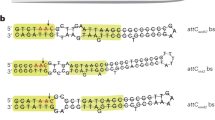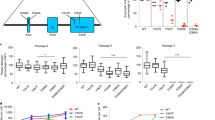Abstract
Herpesviruses are important pathogens in animals and humans. The large DNA genomes of several herpesviruses have been sequenced, but the function of the majority of putative genes is elusive. Determining which genes are essential for their replication is important for identifying potential chemotherapy targets, designing herpesvirus vectors, and generating attenuated vaccines. For this purpose, we recently reported that herpesvirus genomes can be maintained as infectious bacterial artificial chromosomes (BAC) in Escherichia coli . Here we describe a one-step procedure for random-insertion mutagenesis of a herpesvirus BAC using a Tn1721-based transposon system. Transposon insertion sites were determined by direct sequencing, and infectious virus was recovered by transfecting cultured cells with the mutant genomes. Lethal mutations were rescued by cotransfecting cells containing noninfectious genomes with the corresponding wild-type subgenomic fragments. We also constructed revertant genomes by allelic exchange in bacteria. These methods, which are generally applicable to any cloned herpesvirus genome, will facilitate analysis of gene function for this virus family.
This is a preview of subscription content, access via your institution
Access options
Subscribe to this journal
Receive 12 print issues and online access
$209.00 per year
only $17.42 per issue
Buy this article
- Purchase on Springer Link
- Instant access to full article PDF
Prices may be subject to local taxes which are calculated during checkout






Similar content being viewed by others
References
Chee, M.S. et al. Analysis of the protein-coding content of the sequence of human cytomegalovirus strain AD169. Curr. Top. Microbiol. Immunol. 154, 125–169 (1990).
Rawlinson, W.D., Farrell, H.E. & Barrell, B.G. Analysis of the complete DNA sequence of murine cytomegalovirus. J. Virol. 70, 8833–8849 (1996).
Mocarski, E.S. in Fields virology (eds Fields, B.N., Knipe, D.M., & Howley, P.M.) 2447–2492 (Lippincott-Raven, Philadelphia; 1996).
Hengel, H., Brune, W. & Koszinowski, U.H. Immune evasion by cytomegalovirus—survival strategies of a highly adapted opportunist. Trends Microbiol. 6, 190–197 (1998).
Glorioso, J.C., DeLuca, N.A. & Fink, D.J. Development and application of herpes simplex virus vectors for gene therapy. Annu. Rev. Microbiol. 49, 675–714 (1995).
Roizman, B. & Sears, A.E. in Fields virology (eds Fields, B.N., Knipe, D.M. & Howley, P.M.) 2231–2296 (Lippincott-Raven, Philadelphia; 1996).
Mocarski, E.S. & Kemble, G.W. Recombinant cytomegaloviruses for study of replication and pathogenesis. Intervirology 39, 320–330 (1996).
Messerle, M., Crnkovic, I., Ziegler, H., Hammerschmidt, W. & Koszinowski, U.H. Cloning and mutagenesis of a herpesvirus genome as an infectious bacterial artificial chromosome. Proc. Natl. Acad. Sci. USA 94, 14759– 14763 (1997).
Delecluse, H.J., Hilsendegen, T., Pich, D., Zeidler, R. & Hammerschmidt, W. Propagation and recovery of intact, infectious Epstein–Barr virus from prokaryotic to human cells. Proc. Natl. Acad. Sci. USA 95, 8245– 8250 (1998).
Stavropoulos, T.A. & Strathdee, C.A. An enhanced packaging system for helper-dependent herpes simplex virus vectors. J. Virol. 72, 7137–7143 (1998).
Berg, C.M., Berg, D.E. & Groisman, E.A. in Mobile DNA (eds Berg, D.E. & Howe, M.) 879–925 (American Society of Microbiology, Washington, DC; 1989).
Haas, R. et al. TnMax—a versatile mini-transposon for the analysis of cloned genes and shuttle mutagenesis. Gene 130, 23–31 (1993).
Kahrs, A.F. et al. An improved mini-transposon system suitable for sequencing, shuttle mutagenesis and gene fusion. Gene 167, 53 –57 (1995).
Posfai, G., Koob, M.D., Kirkpatrick, H.A. & Blattner, F.R. Versatile insertion plasmids for targeted genome manipulations in bacteria: isolation, deletion, and rescue of the pathogenicity island LEE of the Escherichia coli O157:H7 genome. J. Bacteriol. 179, 4426–4428 (1997).
Jenkins, F.J., Casadaban, M.J. & Roizman, B. Application of the mini-Mu-phage for target-sequence-specific insertional mutagenesis of the herpes simplex virus genome. Proc. Natl. Acad. Sci. USA 82, 4773–4777 (1985).
Jenkins, F.J. & Roizman, B. Herpes simplex virus 1 recombinants with noninverted genomes frozen in different isomeric arrangements are capable of independent replication. J. Virol. 59, 494–499 (1986).
Weber, P.C., Levine, M. & Glorioso, J.C. Rapid identification of nonessential genes of herpes simplex virus type 1 by Tn5 mutagenesis. Science 236 , 576–579 (1987).
Sacks, W.R. & Schaffer, P.A. Deletion mutants of the herpes simplex virus type 1 immediate early protein ICP0 exhibit impaired growth in cell culture. J. Virol. 61, 829– 839 (1987).
Martinez, R., Sarisky, R.T., Weber, P.C. & Weller, S.K. Herpes simplex virus type 1 alkaline nuclease is required for efficient processing of viral DNA replication intermediates. J. Virol. 70 , 2075–2085 (1996).
Spaete, R.R., Gehrz, R.C. & Landini, M.P. Human cytomegalovirus structural proteins. J. Gen. Virol. 75, 3287–3308 (1994).
Chang, Y.E. & Roizman, B. The product of the UL31 gene of herpes simplex virus 1 is a nuclear phosphoprotein which partitions with the nuclear matrix. J. Virol. 67, 6348– 6356 (1993).
Simon, M.I. Dysfunctional genomics: BACs to the rescue. Nat. Biotechnol. 15, 839 (1997).
Ebeling, A., Keil, G.M., Knust, E. & Koszinowski, U.H. Molecular cloning and physical mapping of murine cytomegalovirus DNA. J. Virol. 47, 421–433 ( 1983).
Blomfield, I.C., Vaughn, V., Rest, R.F. & Eisenstein, B.I. Allelic exchange in Escherichia coli using the Bacillus subtilis sacB gene and a temperature-sensitive pSC101 replicon. Mol. Microbiol. 5, 1447–1457 (1991).
Acknowledgements
We thank A. Hegele and A. Colomar for excellent technical assistance, R. Haas for providing the TnMax system, and J. Heesemann for helpful suggestions. This work was supported by grants from the Deutsche Forschungsgemeinschaft, the Boehringer Ingelheim Fonds, the Bundesministerium für Bildung und Forschung, and the European Union.
Author information
Authors and Affiliations
Corresponding author
Rights and permissions
About this article
Cite this article
Brune, W., Ménard, C., Hobom, U. et al. Rapid identification of essential and nonessential herpesvirus genes by direct transposon mutagenesis. Nat Biotechnol 17, 360–364 (1999). https://doi.org/10.1038/7914
Received:
Accepted:
Issue Date:
DOI: https://doi.org/10.1038/7914
This article is cited by
-
Identification of non-essential loci within the Meleagrid herpesvirus 1 genome
Virology Journal (2015)
-
Epstein-Barr virus genetics: talking about the BAC generation
Herpesviridae (2010)
-
Comprehensive identification of essential Staphylococcus aureus genes using Transposon-Mediated Differential Hybridisation (TMDH)
BMC Genomics (2009)
-
Infection of human cytomegalovirus in cultured human gingival tissue
Virology Journal (2006)
-
In vitro transposon mutagenesis of an equine herpesvirus 1 genome cloned as a bacterial artificial chromosome
Archives of Virology (2006)



